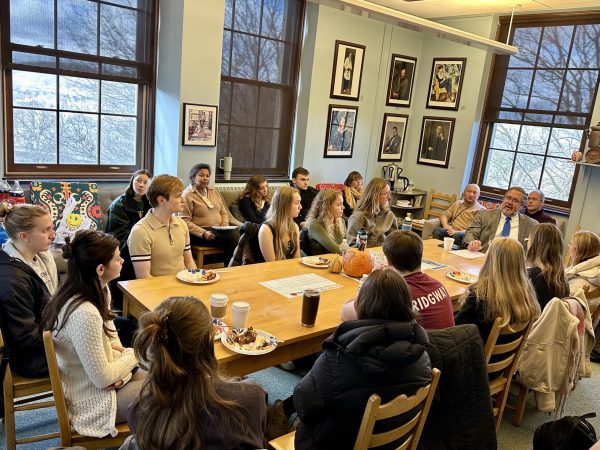Winter Institute Shares its Vision for Racial Reconciliation
The Colgate community welcomed representatives from the University of Mississippi’s William Winter Institute for Racial Reconciliation on Monday, February 23. Founded in 1999, the William Winter Institute seeks to help build and support a movement of racial equity and wholeness. In their presentation to Colgate students and community members, the staff members from the Winter Institute described current strategies used to address the intractable issue of discrimination.
The Winter Institute’s Community Building Coordinator April Grayson prefaced the discussion by sharing the institute’s ultimate goal and mission statement.
“The Winter Institute for Racial Reconciliation envisions a world where people honestly engage in their history in order to live more truthfully in the present where the inequities of the past no longer dictate the possibilities of the future. We envision a world where people of all identities are treated equally, where equality of and access to opportunity are available and valued by all, where healing and reconciliation are commonplace and social justice is upheld and honored. We acknowledge and recognize that it is not enough for us to be intentional, but we must be purposeful in making this vision a reality,” Grayson said. Grayson discussed the importance of “self-reflection” that the Winter Institute promotes and the significance that this holds for the community.
Jennifer Stollman, Academic Director at the Winter Institute, spoke at length during the forum about achieving racial reconciliation with a focus on college campus communities.
“We have to talk on our campuses openly, honestly and clearly about racism, classism, sexism, homophobia and any other kind of oppression because it gives our students the realities of the world that they’re sitting in, the world that they come from and the world that they will be going into,” Stollman said.
For the remainder of the discussion, Stollman outlined her restorative justice model as a mechanism for achieving the aforementioned goals.
“One way to create more equitable campuses … is a restorative justice model, and more specifically its nuanced definition of the term ‘victim.’ I humbly suggest that obvious perpetrators are in fact also victims. They are caught in a cycle of violence; they are repeatedly victimized by false and reimagined cover narratives related to their identities and assumptions about their ‘divined’ roles in society,” Stollman said.
“I am not an oppressor apologist. Rather, if we’re interested in dismantling this very complicated and fortified oppressive system, we have to examine the damage done to, of course, minority students, but also we should consider focusing on the victimization of traditionally empowered group identity students. I argue that our inattention to how this cycle of oppressive thought and action encourages undergraduates, who come from traditionally empowered spaces and groups, [to] become fully baptized on our campus into divided systems as they move from adolescence to adulthood, [and] they graduate from being victims of supremacy systems to perpetrators.”
Stollman emphasized the importance of restorative justice as a way to begin a necessary conversation about on-campus discrimination and racism.
In the question and answer segment that followed the presentation, sophomore Antoinette Nwabunnia questioned Stollman’s proposed method of achieving racial reconciliation.
“Is it possible that your method creates more complacency, rather than actually addressing that people are complacent in the system? Don’t you think that it’s possible that, by addressing these issues by saying that [traditionally empowered groups] are victims in a system … it makes it harder for them to acknowledge the pain that they’re inflicting on other people?” Nwabunnia asked.
Stollman took this opportunity to expand on her method’s ultimate strategy as a way to achieve the Winter Institute’s goals.
“In what I was describing, identifying traditionally empowered students as victims is not the end of the conversation. It is the beginning of a restorative justice process. It does not give them an out; it actually gives them an entryway,” Stollman said.
“We tell our students, ‘You are not responsible for the last 400 years of inequality, but you are responsible for an equality on this campus and as you take your place as an adult in your communities and in your professions.’”





